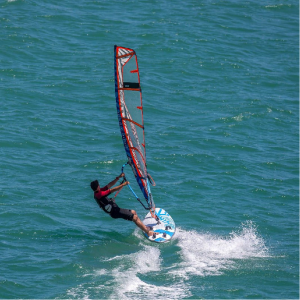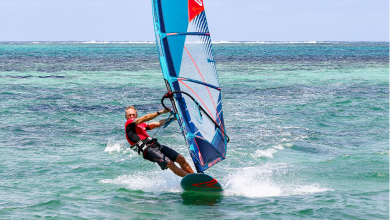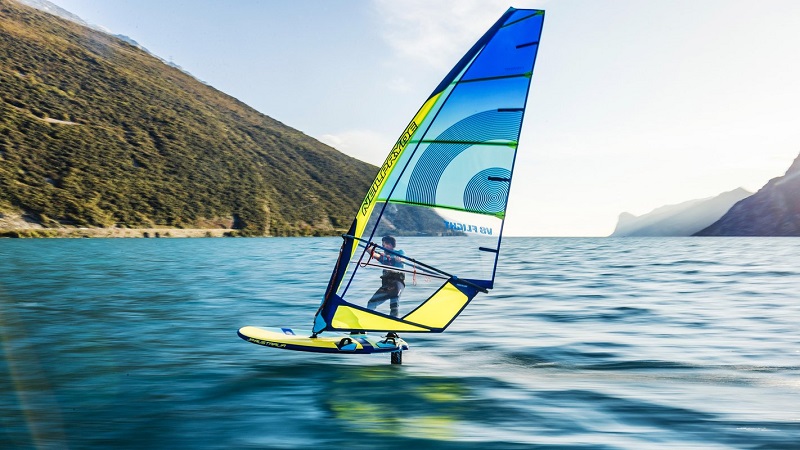Windsurfing: 7 important tips before taking to the water

Surfing in the sea and feeling the wind is so exciting that it is not surprising that windsurfing is one of the most popular water sports. Do you want to try it? Before sailing the seas by sailing, read these seven tips.
Windsurfing Demands
Windsurfing is a very demanding sport. First of all, you have to synchronize balance and navigation control. And things get complicated when there are likes of wind or strong currents. When windsurfing, you have to tense your whole body from head to toe, especially your back, and you can fall into the water at any time!

To learn, it helps to have a good physical condition and well-trained muscles. Of course, knowing how to swim is a fundamental requirement. If you suffer from acute back problems, it is not recommended to practice this sport.
As for clothing, you have to wear neoprene boots and you can choose between a swimsuit or a wetsuit, depending on how cold the water is.
Windsurf Sails
There are different windsurfing sails, suitable for different conditions and different levels. There are three main categories:
Wave sails: they are very resistant and are used to surf the waves.
Shallow Water Sails: These sails are designed for fast gliding over the water. While freerace sails are intended for professionals, freeride sails are used by all windsurfers, so they are the most common.
Maneuvering sails: these are particularly light and easy to maneuver sails, so they are ideal for doing tricks on the water.
Windsurf Board
The second of the essential elements to practice this sport is the table. There is more than one variation, but these models especially stand out:
Freeride board: perfect for beginners starting to surf flat water. Freeride boards are wide and slide very fast.
Wave board: designed for advanced athletes who want to slide and jump on the waves.
Raceboard: allows you to reach high speeds in the water. They give less room to do tricks and maneuvers.
Freestyle board: ideal if you want to do tricks and maneuvers, but not to pick up a lot of speed.
Freestyle wave board: a hybrid board that for many offers the perfect formula: it allows both tricks and fast surfing.
Direction In Windsurfing
To practice windsurfing, the wind is decisive. There are several differences:
The crossing or wind by the tack: the wind hits the surfboard. At first, it goes in this direction.
Upwind sailing: the wind hits the surfboard diagonally. It is used immediately after leaving. A certain angle against the wind is adopted.
Sailing long: the wind hits the surfboard diagonally from behind. This is the fastest way to cover the greatest distance. In this way, you sail away from the wind.
Tailwind: If you sail downwind, the wind is directly behind you. This is the slowest direction.
The wind is very important in windsurfing. Simply put, the more there is, the better. However, beginners need a light wind to get used to the materials and equipment and to work on their balance at a low speed.
Rules In The Water
The practice of this sport entails certain dangers. Windsurfing depends not only on your skills but also and above all on the wind and water conditions, which can change at any time, especially on beaches with rougher waters, which tend to attract many advanced surfers. Sudden likes or currents can be a threat if you are not careful and force you to make very quick decisions. Be careful when you are in the water. It is not recommended to practice it alone, especially if you are a beginner. In this case, you always have to be accompanied by a specialist.
Alternatives To Windsurfing
Strong waves and lack of wind are not friends of this sport. In order not to get frustrated when the weather is bad, learn other water sports as an alternative. There are practices that are not only very exciting and stimulating but also complement your windsurfing exercises. These options are also good if you discover that this sport is not your thing after several attempts. On the most popular beaches with a lot of movement, you can always find a school, as well as nearby shops with materials from different brands for your level, from a board to a wetsuit.
Other very popular water sports:
Paddle surf or stand-up paddle: In this sport, you face the waves while standing on a large surfboard. As for the material, there is no need to worry too much: we only need the board and a paddle to move forward, as well as a harness and tie ropes for the ankle and knee. If you need to add accessories for more security, do not hesitate to use a life jacket. You can also store food and small items in a waterproof bag.
Kitesurfing: The optimal conditions for kitesurfing are the same as for windsurfing: lots of wind and few waves. Kitesurf boards are much smaller and resemble snowboards. Instead of sail, you get pulled by a big kite.
Wakeboarding: It doesn’t matter how windy or how many waves there are: you can always practice wakeboarding. The necessary material is more sophisticated, because, in addition to a board, you need a boat to drag you.
In addition to these examples, there are sports of all kinds to put your body in direct contact with the water, such as jet skiing, diving, snorkeling, canoeing, water skiing, and windfoil. Put on your swimsuit or wetsuit and enjoy: it’s all a matter of trying them on!
Windsurfing: Conclusions
- Anyone in the good physical condition and a good swimmer can windsurf. It is not recommended to do it with back problems.
- The ideal conditions for windsurfing are basically a lot of wind and few waves. For beginners in windsurfing, one of the main tips is to train with little wind to learn better and get better results.
- The wind is a determining factor.
- To practice windsurfing, you need a surfboard, a sail with a mast, a boom, and a harness. There are several versions of windsurfing with different levels of requirements.
- The most important rules are: never surf at night or without anyone’s company, be careful with obstacles and obey traffic regulations.
- There are more popular water sports, such as paddle surfing, kitesurfing, and wakeboarding, among others.
You may also be interested in What windsurf board to buy?



